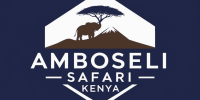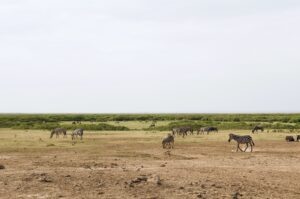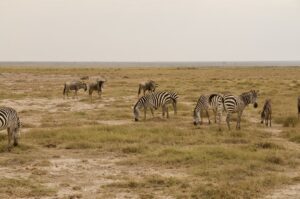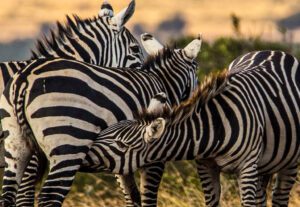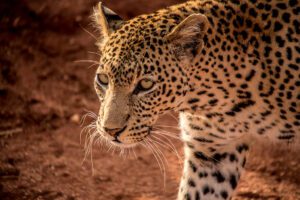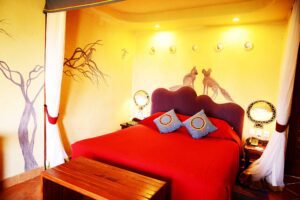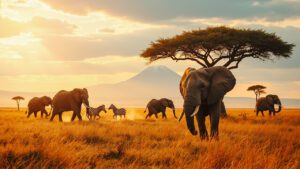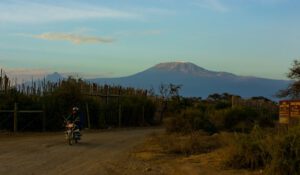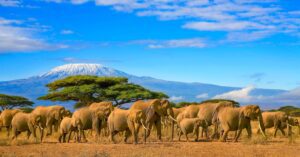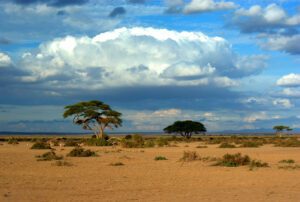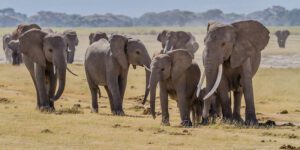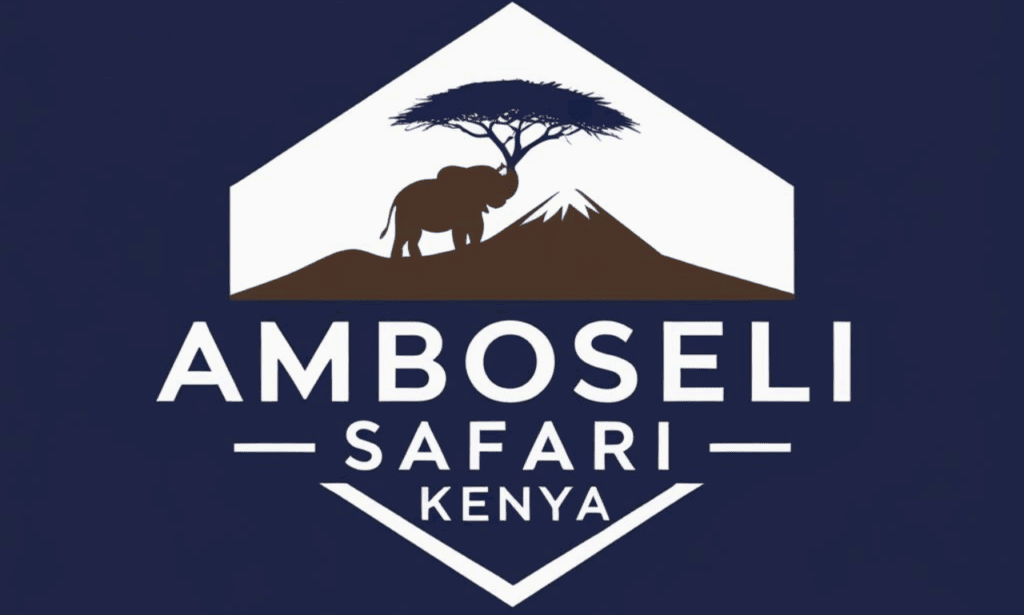What are the best camps available in Amboseli?
Amboseli National Park is home to some of the best safari camps in Kenya, offering a unique experience for travelers. These camps range from luxurious to budget-friendly options, designed to meet the needs of different types of visitors. Here are some of the top camps:
- Tortilis Camp Amboseli: This luxury camp is one of the most well-known in the region. It offers stunning views of Mount Kilimanjaro and sits near a private conservancy. The thatched roof tents come with large, comfortable beds and en-suite bathrooms. It’s an eco-conscious camp and perfect for those who want a luxury experience while being close to nature.
- Elewana Collection Camps: Elewana Amboseli offers another luxurious option, with all-inclusive services like game drives, excellent dining experiences, and spacious accommodations.
- Kibo Safari Camp: Kibo is more mid-range but is very popular due to its affordability while still providing lovely tents, a swimming pool, and vibrant local cultural experiences.
- Satao Elerai Camp: Set on a private conservation area, Satao Elerai offers a blend of luxury and privacy. Its location allows visitors to see wildlife in a quieter setting, away from crowds.
- Amboseli Serena Safari Lodge: Though more of a lodge than a tented camp, it deserves mention for its excellent amenities and prime position within the park. Serena properties are well-known for comfort and good dining.
- Porini Amboseli Camp: Located in the Selenkay Conservancy, Porini is an eco-friendly camp that focuses on a personal experience in smaller groups. Staying here provides a more intimate experience with access to both the conservancy and park.
Each of these camps caters to a different kind of traveler, whether you’re looking for ultimate luxury (Tortilis and Elewana), a mid-range choice with comfort (Kibo Safari Camp), or eco-conscious and community-focused options (Porini and Satao Elerai).
What is the approximate cost of staying in camps in Amboseli?
The cost of staying in Amboseli varies greatly depending on the type of camp you choose, luxury, mid-range, or budget, as well as the time of year you visit (high season vs. low season).
For luxury camps like Tortilis Camp or the Elewana properties, expect to pay anywhere from $500 to $1,000+ per person per night. This price often includes not only accommodation but also meals, game drives, and other activities. High seasons, like July to October (when wildlife is abundant and the weather is perfect), tend to be more expensive, while low seasons (April and May) may offer discounts.
Mid-range camps such as Kibo Safari Camp usually cost between $150 to $300 per person per night. These options often provide plenty of comfort and great facilities, like pools, but might have fewer exclusive activities or smaller teams.
If you’re on a tighter budget, there are budget-friendly camps that cost between $50 to $100 per person per night. However, facilities are more basic, and often, things like game drives or meals come with extra fees. Examples of budget camps include camping sites adjacent to the park or simple accommodations like hostels nearby.
Remember, most of these prices are all-inclusive, which means your accommodation, meals, and sometimes even activities like safari drives or guided walks are included. It’s best to confirm what’s covered when booking to avoid additional costs.
For families or groups, some camps offer packages and discounts for children. Booking during the off-season can also significantly reduce costs. Finally, you’ll want to keep in mind added expenses like park entrance fees (approx. $60 for adults per day).
In summary, Amboseli has options for every type of traveler, whether you’re willing to splurge or traveling on a budget.
What types of accommodation do these camps offer (luxury, mid-range, budget)?
The renowned Amboseli National Park camps provide three main types of accommodations: luxury tents, mid-range options, and budget-friendly guest areas, catering to diverse traveler preferences.
1. Luxury Accommodations
These luxury tents and lodges focus on providing the most comfortable and exclusive experiences for an unforgettable African adventure. Often featuring en-suite bathrooms, large beds with high-quality linens, and private decks with views of the scenic spot of Mount Kilimanjaro or wildlife, some even offer personal butlers. Examples include Tortilis Camp and the Elewana Collection, where guests can enjoy private game drive vehicles, gourmet dining, and spa treatments.
2. Mid-Range Accommodations
If you’re looking for a balance between comfort and affordability, mid-range options like Kibo Safari Camp are a good choice. You’ll still enjoy comfortable en-suite tents or rooms, but they are simpler compared to luxury accommodations. You might not get extras like private guides, but the overall experience can still be exceptional, including delicious meals, cozy sitting areas, and occasionally amenities like a pool.
3. Budget Accommodations
For travelers wanting a more affordable experience, there are budget options available. These camps are very basic and can include simple tent setups or shared facilities like bathrooms or kitchens. While these camps may not offer a lot of frills, they still provide access to Amboseli’s incredible wildlife and scenery. Some budget options are located on the edges of the park and offer bring-your-own-tent camping.
Each of these accommodation types allows visitors to experience the charm of Amboseli and enjoy the park’s unique blend of wildlife and scenic beauty. Your choice will depend on your budget and the kind of experience you desire, whether it’s a luxurious escape or a more rugged, adventurous stay.
What unique experiences do camps in Amboseli provide?
Staying in a luxury tent in Amboseli National Park allows guests to enjoy unique, memorable experiences that go beyond a typical safari. One standout feature is waking up with views of Mount Kilimanjaro, the tallest mountain in Africa, right in the background. This iconic snow-capped peak makes for breathtaking sunrises and sunsets, providing a perfect photo opportunity for every visitor. The scenery is so majestic that Amboseli is sometimes called the “Land of Kilimanjaro.”
In addition to stunning scenery, many porini camps in Amboseli specialize in up-close encounters with wildlife, especially elephants. Amboseli is known as one of the best places in the world to observe elephants in their natural habitat. Some camps even offer guided tours focused on these gentle giants, where guests learn about elephant behavior and conservation efforts. For example, you might see families of elephants grazing freely near your camp or watch them gather at waterholes, an experience you won’t likely forget.
Another unique experience is cultural immersion. Many camps offer visits to nearby Maasai villages. The Maasai are a proud and unique ethnic group native to this region. Visitors to these villages can learn about their traditions, witness traditional dances, and even learn how they build their homes (called “manyattas”). It’s a great way to connect with the local community and understand their lifestyle.
Some camps also provide guided night drives, allowing guests to see nocturnal animals that they wouldn’t spot during the day, like predators on the prowl or unique animals like aardvarks and civets. Luxury camps may even provide options for “bush dinners” under the stars, where guests dine in nature while protected by rangers.
All in all, staying at an Amboseli camp offers stunning views, top-notch wildlife viewing (especially elephants), cultural experiences with the Maasai, and sometimes even magical dining or night adventures. It’s a well-rounded experience that blends nature, wildlife, and culture.
Are the camps located within the Amboseli National Park or in the surrounding areas?
Camps in Amboseli are found in two main areas: inside the park boundaries and in the surrounding private conservancies or buffer zones. Both locations offer unique advantages, and your choice would depend on the type of experience you’re looking for.
Camps located inside Amboseli National Park put you right at the center of the action. These camps typically offer unparalleled access to wildlife, as the animals often roam freely within the park. Staying within the park means you’re closer to key attractions like Observation Hill (a great lookout point) and the marshes where elephants, hippos, and birds congregate. For those eager to maximize their time with the wildlife and scenery, staying inside the park is often the more convenient option.
However, there are also many camps in the surrounding areas, often located on private lands or conservancies that border Amboseli. These camps can often provide a more exclusive experience because they operate outside of the park’s public areas. Since private conservancies typically have fewer tourists, you may have more intimate safari experiences that allow you to connect deeply with nature. Additionally, camps in these areas may offer unique activities like guided nature walks or night safaris, which are generally not allowed inside the national park itself.
For instance, some camps in private areas work closely with local Maasai communities to provide authentic cultural tours as part of the package. They may also include spectacular views of Mount Kilimanjaro, giving you that same stunning vista without needing to stay directly in the park.
Whether you stay within the park or just outside it, you’ll still have great access to Amboseli’s incredible wildlife and landscapes. Both types of camps have their own charm: inside the park offers proximity, while the surrounding areas focus more on privacy and exclusivity.
What wildlife and scenery can be expected when staying in an Amboseli camp?
Amboseli is one of Africa’s most famous wildlife destinations, and its luxury tent accommodations provide amazing opportunities to connect with nature and take in stunning scenery. First and foremost, Amboseli is renowned for its large population of African elephants. You’ll see herds of elephants calmly grazing across the plains, often with Mount Kilimanjaro towering in the background, a sight that looks straight out of a postcard.
Aside from elephants, other wildlife is abundant. Amboseli is home to lions, cheetahs, hyenas, zebras, giraffes, and buffalo. You’ll also likely spot wildebeest, warthogs, and the occasional leopard if you’re lucky. The waterholes and marshy areas attract a variety of animals, meaning no two game drives are the same. Birdwatchers will also find heaven here, as Amboseli hosts over 400 bird species, including flamingos, pelicans, eagles, and storks.
The scenery is spectacular and diverse. One of the most iconic sights is Mount Kilimanjaro, which dominates the horizon with its snow-capped peak. The mountain, coupled with Amboseli’s flat, open plains, creates beautiful contrasts that photographers adore. The park also features lush swamps, which are fed by underground water from Kilimanjaro, providing lifelines for animals during the dry season. You might see hippos wallowing in the water or herds of animals gathering for a drink, all while enjoying a cultural tour of the area.
Amboseli’s scenery changes with the seasons. During the dry season, the landscape can appear dusty and arid, which creates dramatic scenes of elephants walking through the haze. In the wet season, the park becomes lush and green, with seasonal lakes forming and attracting migratory birds.
In summary, whether it’s the iconic elephants, big predators, diverse birdlife, or the grand backdrop of Mount Kilimanjaro, camps in Amboseli allow you to fully immerse yourself in some of the best wildlife and scenery Africa has to offer, making it a perfect destination for your next African adventure.
What activities are offered by the camps (e.g., game drives, cultural visits, nature walks)?
Camps in Amboseli offer a variety of exciting activities that allow visitors to fully immerse themselves in the beauty and culture of the area. One of the most popular activities is game drives, where you’re taken out in specialized safari vehicles to explore the renowned Amboseli National Park and spot incredible wildlife like elephants (Amboseli is known for its large elephant herds), lions, giraffes, zebras, and cheetahs. These drives can take place in the early morning, late afternoon, or even at night, depending on the camp’s policies. Early morning and late evening are usually the best times because wildlife is more active.
Many camps also offer cultural tours to nearby Maasai villages, giving guests the opportunity to learn more about the Maasai people, their traditions, and their way of life. This could include seeing traditional dances, visiting local homes, and learning about how they coexist with the wildlife in the area. It’s an eye-opening experience and a highlight for many visitors.
Nature walks or guided bush walks are another common activity offered by Amboseli camps. Accompanied by experienced guides, you can explore areas near the camp on foot, learn about the flora and smaller creatures you can’t see from a safari truck, and possibly encounter wildlife at a closer level. This helps you connect deeply with the environment and see Amboseli from a different perspective.
Some luxury tent accommodations may also offer more specialized activities, like photography safaris (Amboseli is famous for stunning views of Mount Kilimanjaro in the background), sundowners (drinks at sunset with breathtaking views), and even hot air balloon safaris (a magical experience allowing you to see the park from above).
Every camp usually has trained guides and schedules tailored to ensure the best experience for guests, making your stay as exciting or relaxing as you like!
What is the best time of year to visit camps in Amboseli?
The best time to visit Porini camps in Amboseli depends on what you want to experience, but generally, the dry season, from June to October and January to February, is the most ideal for wildlife viewing. During these months, the weather is sunny and dry, and there’s less vegetation, making it easier to spot animals. Large herds of wildlife often gather around the park’s few water sources, like swamps and springs, providing great opportunities for an unforgettable safari adventure.
The wet season, which occurs from March to May (long rains) and November to December (short rains), is considered the low season for tourism. Although there may be occasional heavy rain, the landscape turns lush and green, creating incredible scenery, especially for wildlife photography. This is also the season when many animals give birth, allowing you to witness adorable baby elephants, zebras, and other wildlife. Birdwatchers especially love the wet season because migratory bird species arrive, adding a burst of color to the surroundings.
One thing to consider is the visibility of Mount Kilimanjaro, which forms a stunning backdrop to Amboseli, especially during sunrise or sunset. While there’s no guarantee you’ll see it clearly (it’s sometimes covered in clouds), dry-season mornings generally offer the clearest views.
If you’re looking for fewer crowds and a budget-friendly experience, visiting right before or after the dry season, in May or early November, can be a good option. Camps often offer discounts during these ‘shoulder periods,’ and the wildlife is still abundant, making it a great time for a family tent or luxury tent experience.
Are meals and other services included in the camp packages?
Yes, most camp packages in renowned Amboseli National Park include meals and a variety of other services, but what’s offered often depends on the type of camp you choose (luxury, mid-range, or budget). Typically, meals are provided as part of full board packages, which means you’ll receive breakfast, lunch, and dinner. Many camps take pride in offering freshly prepared food, with menus designed to cater to a range of tastes, including African and international cuisines. For example, you might have a breakfast buffet with fresh fruits, eggs, and pastries, a picnic lunch while out on a game drive, and a three-course dinner under the stars.
Luxury camps often go above and beyond, offering gourmet meals, private dining experiences, and snacks with drinks during activities like sundowners. Some even provide custom menus for those with special dietary requirements, such as vegetarians, vegans, or individuals with allergies. This attention to detail enhances your safari adventure, making it even more memorable.
In terms of other services, packages often include guided game drives, bush walks, and cultural visits led by a knowledgeable Maasai guide. Luxury camps may offer additional amenities like massage services, laundry, and personalized safari itineraries. Budget-friendly camps may include fewer services, but you’ll still get meals and standard game drives. It’s always good to check with the camp in advance to understand what’s covered, so you don’t run into unexpected costs.
For drinks, some camps include water, tea, and coffee in their packages, while alcoholic beverages and sodas might come at an extra charge. Again, this varies by camp, but many offer all-inclusive deals where everything is covered. Knowing ahead of time means you can enjoy your time in Amboseli without worrying about hidden costs!
How can one get to the camps in Amboseli (transport options)?
Getting to Amboseli camps involves a few straightforward options depending on your preferences, schedule, and budget. Amboseli National Park is located in southern Kenya, near the Kenyan-Tanzanian border. The two main ways to reach Amboseli are by road or by air, and each has its advantages.
- By Road:
- If you’re up for a scenic road trip, traveling by road is highly popular. From Nairobi (Kenya’s capital), it’s roughly a 4-5 hour drive (about 240 km). The roads are mostly good, but the final stretch to the park entrance can be bumpy.
- Visitors often hire private safari vehicles through tour operators to ensure comfort and expertise in navigating local terrain. They also stop at scenic spots, giving you more opportunities to soak in Kenya’s landscapes.
- If you’re traveling on a tighter budget, you can take public transport to towns near the park, such as Namanga or Emali, but you’ll need private transfers for the final leg to your camp.
- By Air:
- For faster travel, flying is an excellent option. Small charter flights operate daily from Nairobi’s Wilson Airport to Amboseli, taking about 45 minutes. Airlines like Safarilink and AirKenya offer convenient flights directly to Amboseli’s airstrip (located near the park).
- Camps or tour operators usually arrange transfers from the airstrip to your lodging. Flying also gives you beautiful aerial views of Mount Kilimanjaro and the surrounding landscapes.
- Transfers from Nearby Locations:
- If you’re coming from another safari destination like Maasai Mara or Tsavo National Park, many tours also offer seamless connections via road or flights.
- Private flights, though more expensive, are sometimes arranged for groups or luxury travelers moving between safari parks.
Whichever option you choose, arriving in Amboseli is part of the adventure, and the journey offers glimpses of Kenya’s diverse landscapes, from bustling towns to arid savannas.
What are the environmental and conservation efforts of these camps?
Many Amboseli camps are deeply invested in protecting the environment and supporting local communities. Since tourism directly impacts the fragile ecosystem and wildlife, most camps make efforts to balance providing a great guest experience with sustainability and conservation.
- Eco-Friendly Practices:
- Camps often adopt environmentally friendly designs and technologies. For example, many camps use solar power for electricity and heating water to reduce dependence on non-renewable energy sources.
- Water conservation is key in the arid Amboseli region, so camps implement practices like rainwater harvesting, recycling wastewater, and using eco-friendly toilets.
- Wildlife Conservation:
- Several camps directly support Amboseli’s wildlife conservation efforts. By partnering with organizations like the Amboseli Trust for Elephants, they help protect vulnerable species such as elephants from poaching and human-wildlife conflicts.
- Some camps contribute a portion of their revenue to conservation initiatives, such as funding anti-poaching patrols or restoring degraded ecosystems.
- Community Involvement:
- Most Amboseli camps work closely with local Maasai communities. These partnerships often involve hiring local staff, offering cultural experiences (like Maasai village visits), and investing in education or healthcare for nearby villages.
- Some camps operate on Maasai-owned land, effectively giving locals a source of income and incentives to protect the environment and wildlife.
- Plastic-Free Initiatives:
- To reduce waste, many camps have moved away from single-use plastics. Instead, they use reusable bottles, biodegradable products, and encourage guests to adopt sustainable tourism practices.
For example, Satao Elerai Camp supports wildlife corridors (used by elephants and lions) on private Maasai land by protecting it from agriculture. Similarly, Tortilis Camp Amboseli is known for its heavy adoption of renewable energy and community outreach.
When you stay at one of these eco-conscious accommodations, you not only enjoy a memorable safari but also contribute to Amboseli’s long-term sustainability.
Are the camps family-friendly or better suited for certain types of travelers (e.g., couples, solo travelers)?
Amboseli camps cater to a range of travelers, from families with kids to couples seeking romance or solo adventurers looking to immerse themselves in nature. Each type of traveler will find something suitable, though some camps focus more on particular experiences or demographics.
- Family-Friendly Camps:
- Many camps design unique programs for families, especially those traveling with kids. These usually include fun, educational activities like guided nature walks, where children can learn about wildlife and Maasai culture.
- Some camps also offer family-style accommodations with larger tents or interconnecting rooms, along with babysitting services to give parents a break.
- Examples of family-friendly camps are Amboseli Serena Safari Lodge and Satao Elerai Camp, which provide flexible options and a safe environment for kids.
- Couples and Honeymooners:
- If you’re looking for a romantic getaway, some camps focus on privacy, luxury, and intimate experiences. Couples can enjoy private sundowner cocktails, candlelit bush dinners, and stunning views of Mount Kilimanjaro.
- These camps often have honeymoon packages that include extra amenities like couples’ spa treatments or hot air balloon rides. For example, Tortilis Camp Amboseli is renowned for its romantic setting, luxurious tents, and personalized service.
- Solo Travelers and Adventure-Seekers:
- Amboseli also accommodates solo travelers well, with small group game drives and communal dining areas that allow you to connect with others. If you’re into photography, camps often organize specialized photo safaris.
- Budget-friendly camps or lodges may attract solo backpackers or adventure types, offering more rustic charm and access to outdoor activities like walking safaris.
Some camps cater to a mix of travelers by offering flexibility in activities and accommodation types, but it’s always a good idea to confirm whether the camp aligns with your group’s needs.
